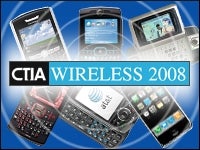 |
SAN FRANCISCO — The Chinese have a curse: May you be born in interesting times. But these interesting times seem to be a blessing for the mobile Internet industry.
Opening the CTIA Wireless IT and Internet conference today, CTIA CEO Steve Largent talked up some highly positive numbers from the wireless industry trade organization’s mid-year data survey, released today.
The wireless industry had record total service revenue, with six-month revenues totaling $72.7 billion, up 7.1 percent year-over-year. Total data service revenues for the six-month period were $14.78 billion, up 40 percent from the same period last year.
“Data revenue now represents 20 percent of carrier income,” Largent told the keynote audience.
In a panel discussion that kicked off the show, the CEOs of the three top U.S. carriers touted open networks as the key to a even greater revenue in the future. That’s a sea change from the conventional telco wisdom that they needed to control what devices could access their networks and which applications could run there.
The change came during the FCC’s spectrum auction, when an unidentified bidder offered $4.7 billion for a block of frequencies in the 700MHz band. Because the bid met the FCC’s reserve price, it put into play an important rule governing the auction: The spectrum winner would have to allow any devices and any applications on the frequencies.
The telecommunications industry not only bowed but appeared to embrace the new rule, although the telco honchos speaking today cautioned the change will come slowly.
While Sprint allowed full HTML browsing on its CDMA
T-Mobile aims to benefit from an expected rush of third-party development that open networks could allow. CEO Robert Dodson admitted that T-Mobile’s time-to-market for new devices is just too long.
“We’re looking at using open source to take advantage of the innovation and creativity that exists beyond our doors,” he said.
Verizon Wireless president and CEO Lowell McAdam echoed that sentiment. While the carriers have had to bet on which devices and applications would be popular, often wasting resources on flops, he thinks there will be a “tidal wave of innovation.”
“All the people making applications for the PC desktop now want to move to mobile,” he said. “We couldn’t handle all that innovation, so opening up the doors and just protecting the network is only thing we have to do. Now, developers will place those bets.”
These statements are somewhat ironic, since in the early days of mobile data services, would-be developers had been stymied by a lack of access to the telcos and their networks.
Dodson said that T-Mobile’s experience letting devices connect to Wi-Fi networks showed some of the problems of open networks. While the wireless routers and software the company provides work well on the network, consumers who wanted to use other routers often had “not very good experiences,” he said.
The same holds true of the few open devices already available. Not all network services may work well, he said; for example, users may have trouble accessing voicemail or sending MMS.
Another issue, according to Hesse, is that consumers using third-party mobile applications will have to go to the developers for tech support.
The opportunity for increased revenue from data services isn’t limited to consumer devices, the panelists said. Wirelessly connected appliances, thermostats, health care devices and sensors, as well as a host of other non-phone devices, will create a huge opportunity.
At the same time, on the consumer front, mobility will be the sine qua non, Hesse said. “If I can’t take it with me, it’s irrelevant.”
“About 20 percent of users will adopt this very rapidly, and if their experience is good, it will grow,” he added. “It’s up to carriers to facilitate this.”


